This question requires that you evaluate the underlined text to determine if it is correct.
Your Azure Active Directory Azure (Azure AD) tenant has an Azure subscription linked to it.
Your developer has created a mobile application that obtains Azure AD access tokens using the OAuth 2 implicit grant type.
The mobile application must be registered in Azure AD.
You require a redirect URI from the developer for registration purposes.
Instructions: Review the underlined text. If it makes the statement correct, select `No change is needed.` If the statement is incorrect, select the answer choice that makes the statement correct.
Answer:
A
For Native Applications you need to provide a Redirect URI, which Azure AD will use to return token responses.
Reference:
https://docs.microsoft.com/en-us/azure/active-directory/develop/v1-protocols-oauth-code
You are creating an Azure key vault using PowerShell. Objects deleted from the key vault must be kept for a set period of 90 days.
Which two of the following parameters must be used in conjunction to meet the requirement? (Choose two.)
Answer:
BD
Reference:
https://docs.microsoft.com/en-us/powershell/module/azurerm.keyvault/new-azurermkeyvault https://docs.microsoft.com/en-us/azure/key-vault/key-vault-ovw-soft-delete
HOTSPOT -
You have an Azure Active Directory (Azure AD) tenant.
You want to implement multi-factor authentication by making use of a conditional access policy. The conditional access policy must be applied to all users when they access the Azure portal.
Which three settings should you configure? To answer, select the appropriate settings in the answer area.
NOTE: Each correct selection is worth one point.
Hot Area: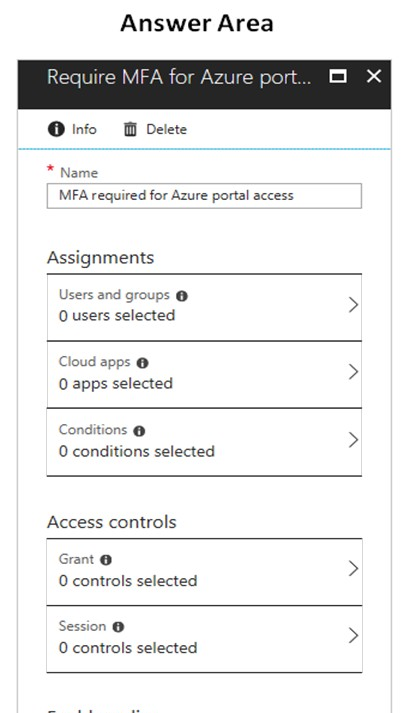
Answer:
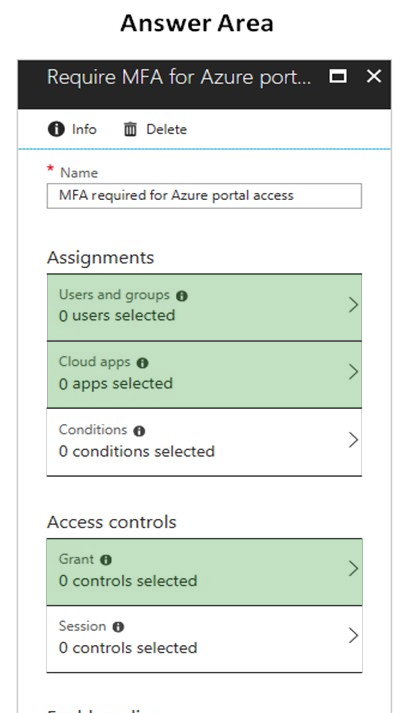
Box 1:
The conditional access policy must be applied or assigned to Users and Groups.
Box 2:
The conditional access policy must be applied when users access the Azure portal, which is a cloud app. That is: Microsoft Azure Management
Box 3:
Access control must require multi-factor authentication when granting access.
Reference:
https://docs.microsoft.com/en-us/azure/active-directory/conditional-access/app-based-mfa
You manage an Azure SQL database that allows for Azure AD authentication.
You need to make sure that database developers can connect to the SQL database via Microsoft SQL Server Management Studio (SSMS). You also need to make sure the developers use their on-premises Active Directory account for authentication. Your strategy should allow for authentication prompts to be kept to a minimum.
Which of the following should you implement?
Answer:
C
Azure AD can be the initial Azure AD managed domain. Azure AD can also be an on-premises Active Directory Domain Services that is federated with the Azure
AD.
Using an Azure AD identity to connect using SSMS or SSDT
The following procedures show you how to connect to a SQL database with an Azure AD identity using SQL Server Management Studio or SQL Server Database
Tools.
Active Directory integrated authentication
Use this method if you are logged in to Windows using your Azure Active Directory credentials from a federated domain.
1. Start Management Studio or Data Tools and in the Connect to Server (or Connect to Database Engine) dialog box, in the Authentication box, select Active
Directory - Integrated. No password is needed or can be entered because your existing credentials will be presented for the connection.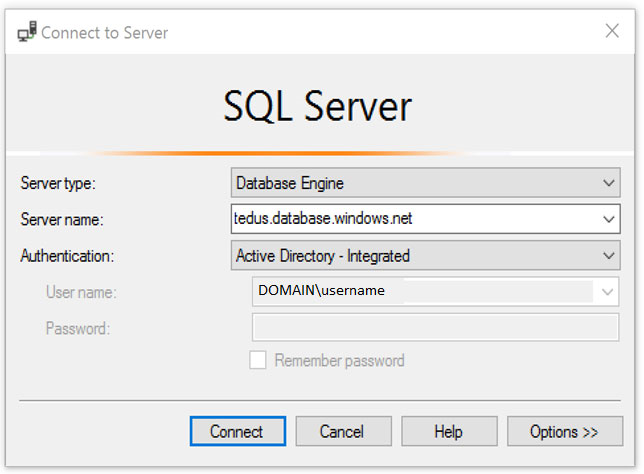
2. Select the Options button, and on the Connection Properties page, in the Connect to database box, type the name of the user database you want to connect to.
(The AD domain name or tenant IDג€ option is only supported for Universal with MFA connection options, otherwise it is greyed out.)
You are developing an application to transfer data between on-premises file servers and Azure Blob storage. The application stores keys, secrets, and certificates in Azure Key Vault and makes use of the Azure Key Vault APIs.
You want to configure the application to allow recovery of an accidental deletion of the key vault or key vault objects for 90 days after deletion.
What should you do?
Answer:
B
When soft-delete is enabled, resources marked as deleted resources are retained for a specified period (90 days by default). The service further provides a mechanism for recovering the deleted object, essentially undoing the deletion.
Purge protection is an optional Key Vault behavior and is not enabled by default. Purge protection can only be enabled once soft-delete is enabled.
When purge protection is on, a vault or an object in the deleted state cannot be purged until the retention period has passed. Soft-deleted vaults and objects can still be recovered, ensuring that the retention policy will be followed.
The default retention period is 90 days, but it is possible to set the retention policy interval to a value from 7 to 90 days through the Azure portal. Once the retention policy interval is set and saved it cannot be changed for that vault.
Reference:
https://docs.microsoft.com/en-us/azure/key-vault/general/overview-soft-delete
HOTSPOT -
You have developed a Web App for your company. The Web App provides services and must run in multiple regions.
You want to be notified whenever the Web App uses more than 85 percent of the available CPU cores over a 5 minute period. Your solution must minimize costs.
Which command should you use? To answer, select the appropriate settings in the answer area.
NOTE: Each correct selection is worth one point.
Hot Area: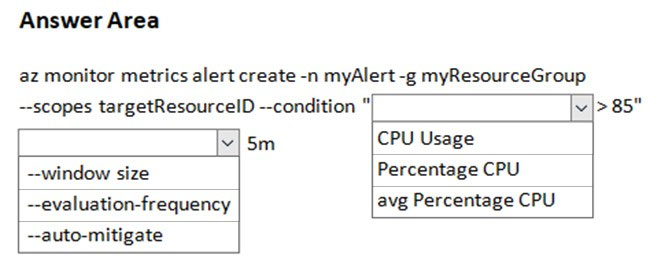
Answer:
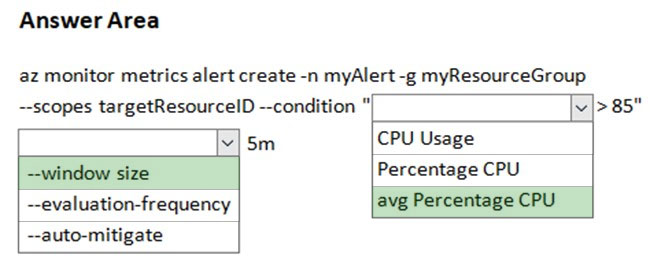
Reference:
https://docs.microsoft.com/sv-se/cli/azure/monitor/metrics/alert
Note: The question is included in a number of questions that depicts the identical set-up. However, every question has a distinctive result. Establish if the solution satisfies the requirements.
You are configuring a web app that delivers streaming video to users. The application makes use of continuous integration and deployment.
You need to ensure that the application is highly available and that the users' streaming experience is constant. You also want to configure the application to store data in a geographic location that is nearest to the user.
Solution: You include the use of Azure Redis Cache in your design.
Does the solution meet the goal?
Answer:
B
Note: The question is included in a number of questions that depicts the identical set-up. However, every question has a distinctive result. Establish if the solution satisfies the requirements.
You are configuring a web app that delivers streaming video to users. The application makes use of continuous integration and deployment.
You need to ensure that the application is highly available and that the users' streaming experience is constant. You also want to configure the application to store data in a geographic location that is nearest to the user.
Solution: You include the use of an Azure Content Delivery Network (CDN) in your design.
Does the solution meet the goal?
Answer:
A
Reference:
https://docs.microsoft.com/en-in/azure/cdn/
Note: The question is included in a number of questions that depicts the identical set-up. However, every question has a distinctive result. Establish if the solution satisfies the requirements.
You are configuring a web app that delivers streaming video to users. The application makes use of continuous integration and deployment.
You need to ensure that the application is highly available and that the users' streaming experience is constant. You also want to configure the application to store data in a geographic location that is nearest to the user.
Solution: You include the use of a Storage Area Network (SAN) in your design.
Does the solution meet the goal?
Answer:
B
You develop a Web App on a tier D1 app service plan.
You notice that page load times increase during periods of peak traffic.
You want to implement automatic scaling when CPU load is above 80 percent. Your solution must minimize costs.
What should you do first?
Answer:
C
Configure the web app to the Standard App Service Tier. The Standard tier supports auto-scaling, and we should minimize the cost. We can then enable autoscaling on the web app, add a scale rule and add a Scale condition.
Reference:
https://docs.microsoft.com/en-us/azure/monitoring-and-diagnostics/monitoring-autoscale-get-started https://azure.microsoft.com/en-us/pricing/details/app-service/plans/